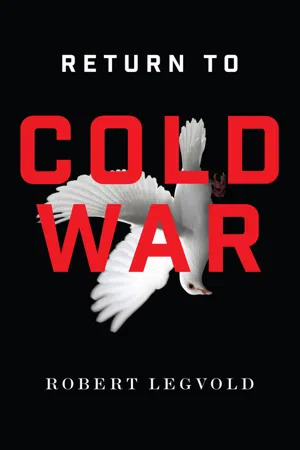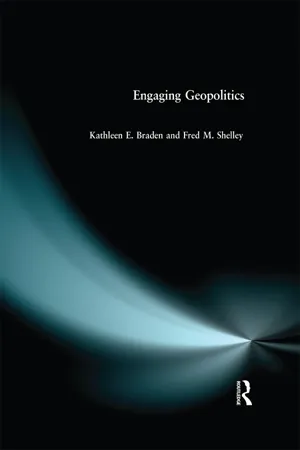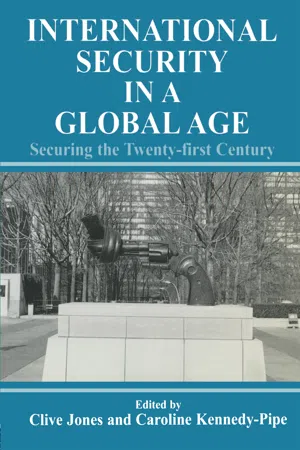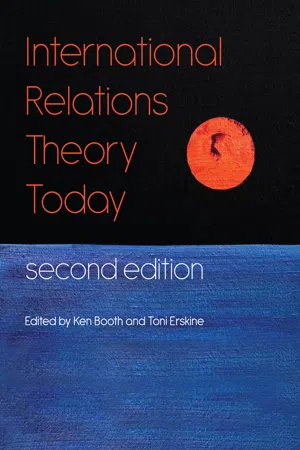History
Second Cold War
The "Second Cold War" refers to a period of renewed geopolitical tension and rivalry between the United States and Russia following the end of the original Cold War. This era is characterized by competition in areas such as military power, influence in global affairs, and technological advancements. While not as intense as the first Cold War, it represents a significant shift in international relations.
Written by Perlego with AI-assistance
Related key terms
9 Key excerpts on "Second Cold War"
- eBook - ePub
The Cold War and After
Capitalism, Revolution and Superpower Politics
- Richard Saull(Author)
- 2007(Publication Date)
- Pluto Press(Publisher)
For Realists 2 the Cold War is understood as the bipolar (superpower) relationship based on strategic competition, which was a consequence of the geopolitical arrangements brought about by the Second World War. In this understanding the Cold War is classified as a typical great power conflict based on the utility of military power and distinguished by the strategic currency of nuclear weapons. 3 From this perspective ideological and socio-economic factors are seen as largely subordinate to the material (military and economic) interests of each superpower; having more explanatory significance for accounts of the domestic political relations of each rather than their respective international relations. 4 Consequently, the end of the Cold War occurred because the USSR was forced to make strategic concessions (withdrawal from east-central Europe, arms control concessions and ending political-military support for allies) to preponderant US material power. Following this explanatory logic, the social and political developments within the Soviet bloc that altered the domestic socio-economic, ideological and political character of communist states are seen as being of secondary import. Ideational approaches 5 share with Realist-informed scholars some key theoretical assumptions about the Cold War: that it was a post-war conflict derived from the consequences of the Second World War, and that it was a conflict centred on the conflicting post-war objectives of the superpowers. Both, then, understand the Cold War as the diplomatic history of the post-1945 Soviet–US relationship. However, in contrast to Realists, ideational approaches emphasise the importance of domestic political ideas, values and ideology on superpower behaviour and, consequently, take much more seriously the ideological character of the Cold War conflict and the way in which domestic political factors (and change) conditioned the bipolar relationship - eBook - ePub
- Robert Legvold(Author)
- 2016(Publication Date)
- Polity(Publisher)
Like any large, complex phenomenon, there are multiple ways to understand the Cold War. Two, however, help better than others to unscramble the tangle of interpretations vying to explain the new Cold War. The first is the venerable and widely accepted conviction that the Cold War was a battle between political and economic systems, underpinned by fundamentally different values, goals, and ontologies. Within this argument the principal contention was over the latter, over the ideological element, and whether it played a primary or secondary causal role. Less conspicuously, a second area of disagreement eventually emerged related to the primary sphere within which the inter-systemic rivalry took place. Scholars looking back over the whole of the Cold War charged that mainstream analysts, particularly international relations theorists, had gotten it wrong by stamping it Euro-centric – that is, as a strategic contest between the United States and the Soviet Union over the fate of the international system’s European fulcrum – when, in fact, the Cold War’s active theater was the Third World (Westad, 2007).If the Cold War, as Fred Halliday (1999) argued, was as much a socio-economic contest for the hearts and minds of much of the globe as an ideological and geopolitical test of wills, then the fluid environment where it raged and, indeed, the point from which it ricocheted back into the anxiety-ridden consciousness of US and Soviet leaders was the vast expanses of a roiling postcolonial world. Halliday, to put a fine point on it, suggested that US “national security doctrines – from Truman to Reagan – were less about responding to Soviet geopolitical maneuvering and more concerned with responding to the geopolitical consequences of localized revolutionary crises” (Saull, 2011).That was inside the argument. Outside of it, the opposing school insisted that the clash of political and economic systems mattered less than a simple, classical slugfest over power. The clash was merely the tissue covering the real muscle controlling events. Beginning with this elemental argument, all of these contested byways echo today. Thus, some argue that the trouble traces back to the wildly different assumptions motivating the two sides. From the Western perspective, everything begins with the red in tooth and claw determination of Russian leaders to reverse the loss of place and power following the collapse of the Soviet Union. From a Russian perspective, the root cause is in the (unexplained) determination of US leaders to diminish Russia and put it in a box. It is a simple struggle for power, and these are its terms. - eBook - ePub
War, Peace and International Relations
An introduction to strategic history
- Colin S. Gray(Author)
- 2013(Publication Date)
- Routledge(Publisher)
14 The Cold War, I
Politics and ideologyReader's guide: The legacy of World War II. The onset of the Cold War. The course of the conflict. Soviet and US performance. Soviet failures.Introduction: from war to peace – the consequences of World War II
The Cold War has passed into history, but the nuclear bomb and the nuclear revolution are here to stay, prospectively for ever. Between them, the bomb and the political context of the Cold War nearly brought strategic history to an abrupt full stop. The human experience in its entirety might well have been concluded violently. How did this happen? And, more to the point, why? This chapter offers a fresh look at the Soviet–American Cold War of 1947–89, while the chapter that follows pays particular attention to its historically novel nuclear dimension.The events and non-events, but possible events, of the Cold War years comprise a contested history among scholars today (Westad, 2000; Herrman and Lebow, 2004). Almost everything about the Cold War is uncertain; at least, it is uncertain if one focuses on issues of motivation and causation. There is no solid consensus on why the Cold War began, who was most responsible for it, or why it concluded with barely a whimper with the loss of the will to power of the Soviet ruling elite in the late 1980s. Fortunately, the historical record provides some compensation for the deeper uncertainties. Even if one cannot be sure exactly why particular decisions were taken, one can secure an adequate grasp of who did what and when. Furthermore, one can proceed to ask and answer the strategist's question: so what? Deeds and their consequences are less mysterious than are motives.One of the themes of this text is the intimate connection between war and peace, and indeed between peace and war. Peace, at least some semblance thereof, follows war. Moreover, peace of a particular character is what a war is all about. It is easy to forget this fundamental fact amid the stress, excitement and difficulties of waging war. The Cold War was a consequence of the changes in context produced by World War II. It is vital to recognize the complex authority of context. It is not quite everything, because individuals matter. But the Stalins, Kennedys and Gorbachevs must exercise their judgement, their somewhat free will, in political, socio-cultural, economic, technological, military–strategic, geographical and historical contexts for which they are largely not responsible. - eBook - ePub
The Cold War
An International History
- David Painter(Author)
- 2002(Publication Date)
- Routledge(Publisher)
6 The rise and fall of the Second Cold War, 1981–91Carter’s successor, Ronald Reagan (1981–89), denounced the Soviet Union as an immoral “evil empire,” and fought the last phase of the Cold War vigorously on all fronts. Alleging that the Soviets were the source of most of the world’s problems, Reagan persuaded the US Congress to approve massive increases in military spending, effectively ended arms control negotiations with the Soviets, and pursued an aggressive policy to roll back Soviet influence in the Third World. Reagan’s policies resulted in a mushrooming budget deficit; a powerful, and at times anti-US, peace movement in Western Europe; strains within the NATO alliance; and a heightening of Cold War tensions.This “Second Cold War” proved short-lived, however. After Mikhail Gorbachev came to power in 1985, the Soviet Union began to pursue policies aimed at improving relations with the United States. With the Soviets making most of the concessions, the United States and the Soviet Union reached important arms control agreements. In 1989, faced with chronic unrest in Eastern Europe and economic decline at home, the Soviets allowed communist regimes in Eastern Europe to collapse. The following year, they agreed to German reunification on Western terms. Improved East-West relations and the Soviet Union’s retreat from a world role also led to the withdrawal of Soviet troops from Afghanistan in early 1989 and facilitated negotiated settlements to local and regional conflicts in southern Africa, Southeast Asia, and Central America.THE NEW COLD WAR
During the Reagan administration (1981–89), the United States intensified the military build-up begun during the last years of the Carter administration and spent over $2 trillion to build up US conventional and nuclear forces. Reagan revived the B-1 bomber program that Carter had shelved, continued development of the B-2 (Stealth) bomber, and accelerated deployment of the MX ICBM and the Trident submarine missile system (very accurate missile systems with MIRV capabilities). Much of the increased expenditure focused on conventional forces, including an expansion of the navy from 450 to 600 ships. The Reagan administration also expanded US covert action and increased US military assistance to pro-US governments and groups, including anticommunist insurgents in Afghanistan, Angola, Cambodia, and Nicaragua. - eBook - ePub
The United States And The Ussr In A Changing World
Soviet And American Perspectives
- Andrei Bochkarev, Don L Mansfield(Authors)
- 2019(Publication Date)
- Routledge(Publisher)
Part One The Evolution of Soviet-American Relations in the Post-War EraPassage contains an image
Section 1 The U.S.-Soviet Rivalry in Perspective
Who could mourn the passing of the Cold War? While the world was divided into two conflicting camps, there was the ever-present danger of nuclear war between the superpowers. Defense spending was at such high levels that the economies of both the Soviet Union and the U.S. were adversely effected. The conflict was on a global scale, with the "zero-sum game" approach to Soviet-American relations evident even in the Third World. The result was that both superpowers had the propensity to impose their conflict upon local conflict throughout the world. It was an ideological struggle that isolated the two nations from one another and produced xenophobia among their citizens. It was a hostile, risky, and wasteful period in the history of both nations. We welcome its demise and are already questioning the causes of such an odious relationship.Despite this euphoria as the superpowers enter a new era of relations, political commentators and strategists have been quick to point out that the Cold War did have its positive features. In fact, some have gone so far as to suggest that the Cold War was actually a blessing, or at least a very useful thing. There is some logic to this view: During the Cold War there was a tested method of maintaining the semblance of world order by means of the bipolar rivalry, of dividing the world into two blocs headed by two military superpowers. It was a crude but effective device, which, John Gaddis argues, could be credited with maintaining the "long peace." These "benefits" of the Cold War are now being compared to the possible consequences of its demise—the disintegration of stable alliances, - eBook - ePub
- Kathleen E Braden, Fred M Shelley(Authors)
- 2014(Publication Date)
- Routledge(Publisher)
3The Cold War
KEYWORDS
blocs, domino theory, containment,détente ,glasnost, shatterbelt, non-alignmentKEY PROPOSITIONS
• New war-fighting technologies and the Soviet/American rivalry dominated post-World War II geopolitical discourse through the 1980s.• The locus of this conflict increasingly shifted to a third world stage and to four major shatterbelt areas.• Europe perceived itself as a buffer between two superpowers, a fact that helped the formation of a European Union.3.1 Introduction
The end of World War II in 1945 brought about substantial and profound changes in international relations. Since the Renaissance, the world economy had been centered in Europe, and geopolitical theory was concerned primarily with European states and their interrelationships. The conclusion of World War II signified that Europe was no longer at the center of the global political economy. After the war, the United States and the Union of Soviet Socialist Republics emerged as the world’s leading powers, while the countries of Europe were dependent on American and Soviet aid to rebuild their war-torn and devastated economies.Conflict between the Americans and the Soviets soon dominated geopolitical thought. Within a very few years, geopolitical and ideological differences between America and Russia were to divide Europe and initiate the Cold War. Sir Winston Churchill’s famous phrase, “an iron curtain has descended across the continent” came to symbolize Europe’s position in post-World War II geopolitics. Europe was no longer in a position to initiate geopolitical change; rather it was a potential battleground, both militarily and economically, between the competing interests of the United States and the Soviet Union. By the 1950s, Western Europe had become incorporated into the American-dominated North Atlantic Treaty Organization (NATO), and thousands of American troops were stationed in Germany and elsewhere in Europe with the intention of protecting Western Europe from potential Russian attacks. Similarly, the Warsaw Pact symbolized the incorporation of Eastern Europe into the Soviet sphere of influence. - eBook - ePub
Europe and America
The End of the Transatlantic Relationship?
- Bindi(Author)
- 2019(Publication Date)
- Brookings Institution Press(Publisher)
PART II The Cold War Superpowers in a Hot WorldPassage contains an image ELEVEN Russia’s Staunch Foreign Policy in a Wavering Landscape SERENA GIUSTI
F or centuries Russian foreign policy has been marked by expansion, militarization, and border defense. The identity of Russia itself has been forged by the country’s capacity to spread out and conquer new territories. While Russia under the czars was long one of the key players in European diplomacy (and also had a strong interest in expanding eastward), under Soviet rule it became a superpower whose ideological and geopolitical influence extended throughout the world. Soviet foreign policy took on a global dimension due to the bipolar nature of the international system, within which Russia and the United States struggled for dominance. The system revolved around the two superpowers, and it relied for its survival on the doctrine of nuclear deterrence based on mutual assured destruction. There were, however, several shifts in alliances as some countries passed from one sphere of influence to the other; other countries were able to maintain nonaligned status.The Kremlin, following the centuries-old strategic logic of Russian imperialism, kept strict control over the Eastern European countries (the so-called satellites) in order to use the region as a buffer against possible military attack by the major Western powers.1 Unlike other empires, the Soviet Union did not fall because it was defeated in war but because the political and economic model on which it was based failed. The bipolar system crashed after the satellites rejected the Soviet legacy for full sovereignty, and the Soviet Union itself imploded quite unexpectedly.Even the international relations theory of realism failed to forecast the end of the rivalry between the great powers, the unilateral Soviet withdrawal from its sphere of influence, and the rise of nationalism. Russia no longer controlled an imperial hinterland in Europe, and it no longer was confronted with a zero-sum relationship with the United States. As Ilya Prizel pointed out, “Within the short space of three years the Russian people have seen the ideology that dominated their polity for seven decades de-legitimized. Worse still, they have lost the vast territories that for centuries [they] considered their own and have witnessed the disappearance of an imperial status that has been part and parcel to Russia’s national being since at least the sixteenth century.”2 - eBook - ePub
International Security Issues in a Global Age
Securing the Twenty-first Century
- Clive Jones, Caroline Kennedy-Pipe(Authors)
- 2020(Publication Date)
- Routledge(Publisher)
Conventional wars in the Third World were incorporated into the Cold War competition, and even the few classic interstate conflicts that might have conformed to a traditional pattern of war were affected by superpower intervention. For example, the Iran–Iraq war waged during the 1980s was prolonged by the provision of superpower aid. So although nuclear competition might have prevented global war, it did not halt and in some cases even facilitated lower-level clashes. Some Soviet ‘adventures’ in the Third World, particularly in Africa were due at least in part to the ability of the Russians to use the nuclear stalemate as a shield from behind which they could apply pressure, deploy military troops, especially surrogate forces, and exert influence in new areas.It is Michael Doyle who has developed the so-called ‘Liberal Peace’ thesis. He is widely credited with elaborating the view that there is a linkage between the spread of democracy and peace, arguing that wars are not fought ‘amongst’ or between democratic states. In the context of the Cold War it is a persuasive claim. On the whole wars waged during the Cold War period were fought between states with non-democratic political systems or were waged by a democratic power against a state or faction with an authoritarian complexion.12Indeed, involvement by the great powers in pursuit of ideological and geostrategic goals came in some ways to define the very nature of civil wars throughout the Cold-War period. It has been estimated that the superpowers intervened in approximately half of all the civil wars that took place during the period of the Cold War while the former colonial and regional powers were involved in many of the other wars. It is quite often overlooked that the Cold War period was also a period of decolonization which engaged many of the European powers in small wars. The overall consequence was not less great power involvement in civil war or low-level conflicts, although an increased use of proxy or surrogate troops to aid particular groups or political factions did characterize superpower engagement in these conflicts. The course of the Angolan civil war in 1975 – a conflict which resulted from the demise of the Portuguese empire – was for example profoundly influenced by the intervention of the Americans, the Russians, the Chinese, as well as the South Africans.13 - eBook - ePub
- Ken Booth, Toni Erskine(Authors)
- 2016(Publication Date)
- Polity(Publisher)
theoretically – of demonstrating how the nuclear revolution can become a sort of IR theory. I do so by contrasting my analysis with that of Robert Jervis, and it is here where I employ the third assumption.The end of the Cold War
The astonishing end of the Cold War is a familiar story and for our purposes need be only briefly summarised. The Soviet Union, a vast empire that continued to wield massive military power, chose in the late 1980s to allow the governments of its client states in Eastern Europe to collapse, to abandon its global and programmatic Marxist ideology, and, in 1991, to put an end to its own existence.9 In other words, the USSR surrendered in its Cold War rivalry with the US, a rivalry it had spent fifty years and billions of roubles and fought many minor wars to sustain. Because the USSR surrendered peacefully, the Cold War came to an end without the systemic war that had terminated previous great power orders and gave birth to new ones. This had never happened before in modern international history.The events of 1989–91 upended the study of international relations, but particularly hard hit were Marxism and structural realism. Although many Marxists had long rejected the USSR as a model, the fact that Soviet communism was readily abandoned by one Eastern European state after another the moment they had their chance, and by the founding regime itself not long afterwards, seriously damaged Marxist ideologies no matter how far they had distanced themselves. As R. N. Berki (1971: 80; also see Gaddis 1992–3) puts it, ‘the system of thought and concrete guide to action into which Marx’s ideas have turned’ had colossally failed, brought down in the end not by cunning imperialists but by its own sclerosis.Structural realists faced a different problem. Rather than undermining their political ideology, the collapse of the USSR seemed instead to invalidate their most central theoretical claim: that the anarchical structure of international political systems is characterised by a military competition among the great powers that eventually culminates in major war (Waltz 1959; Gilpin 1981; Lebow 1994).
Learn about this page
Index pages curate the most relevant extracts from our library of academic textbooks. They’ve been created using an in-house natural language model (NLM), each adding context and meaning to key research topics.








